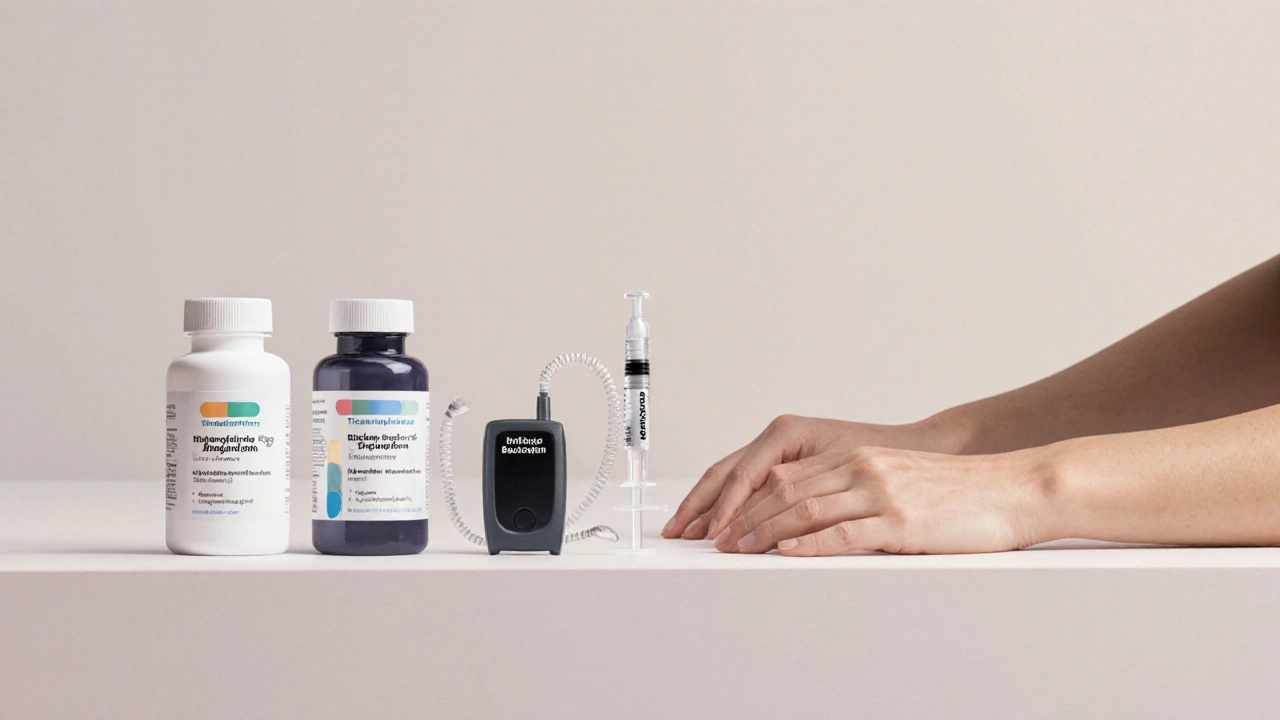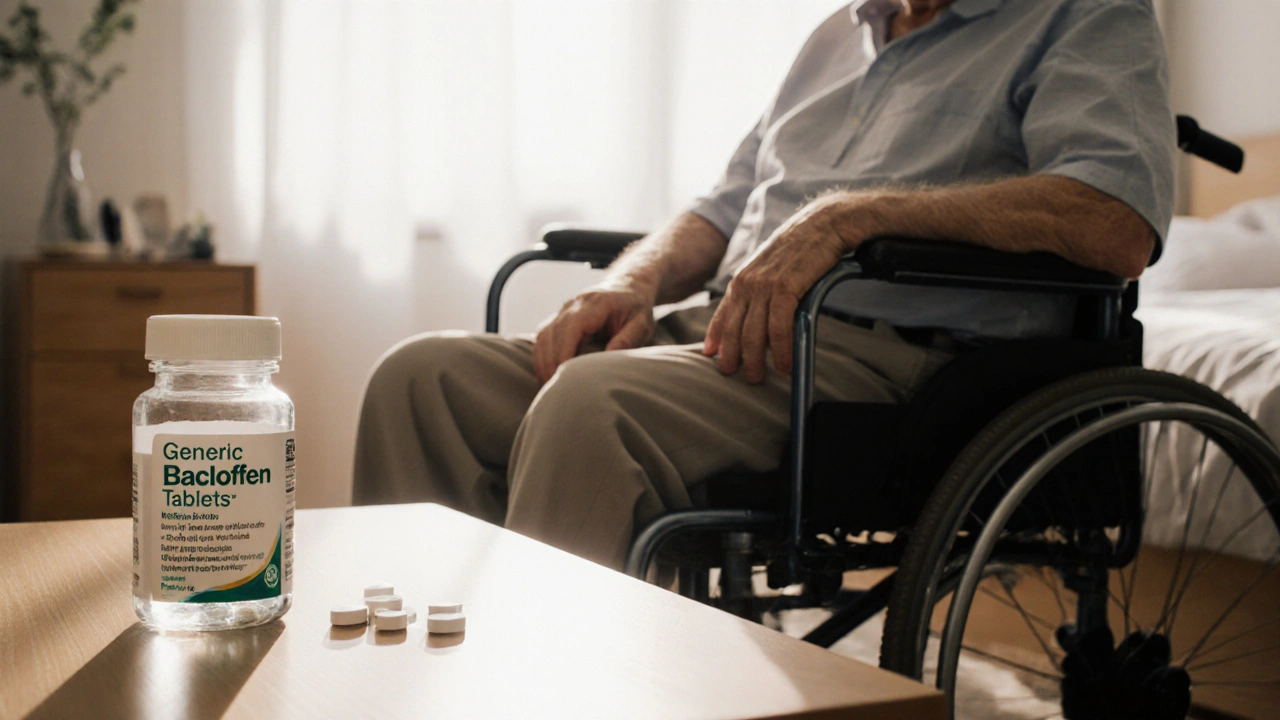Lioresal vs. Alternative Spasticity Treatments Comparison Tool
Select Treatment Options to Compare
When it comes to managing muscle spasticity-whether from multiple sclerosis, spinal cord injury, or cerebral palsy-choosing the right medication can feel like a maze. Lioresal comparison helps you cut through the confusion by laying out how Lioresal stacks up against the most common alternatives, what each drug does, and which factors matter most for you or your loved one.
What Is Lioresal?
Lioresal is the brand name for baclofen, a gamma‑aminobutyric acid (GABA‑B) receptor agonist. It’s been on the market since the 1970s and is prescribed mainly for reducing muscle tone in spasticity.
- Typical oral dose: 5-20mg three times daily, titrated up to 80mg per day.
- Onset of effect: 30-60minutes after ingestion.
- Common side effects: drowsiness, dizziness, weakness, and dry mouth.
How Lioresal Works - Key Attributes
By stimulating GABA‑B receptors in the spinal cord, Lioresal dampens the reflex arcs that cause involuntary muscle contractions. This mechanism makes it especially good for generalized spasticity rather than focal muscle tightness.
| Attribute | Value |
|---|---|
| Mechanism | GABA‑B agonist |
| Typical dosage | 5‑80mg/day |
| Onset | 30‑60min |
| Half‑life | 2‑4hours |
| Cost (US, generic) | ~$0.30 per tablet |

Top Alternative Medications
Below are the most frequently used alternatives, each with its own strengths and drawbacks.
Tizanidine is a central alpha‑2 adrenergic agonist that reduces spasticity by inhibiting excitatory motor neurons.
- Typical oral dose: 2-4mg up to three times daily.
- Side effects: dry mouth, sedation, low blood pressure.
Diazepam (Valium) belongs to the benzodiazepine class and works by enhancing GABA‑A activity.
- Typical oral dose: 2-10mg 2‑3 times daily.
- Side effects: strong sedation, dependence risk, respiratory depression.
Dantrolene acts directly on skeletal muscle by blocking calcium release from the sarcoplasmic reticulum.
- Typical oral dose: 25-100mg three times daily.
- Side effects: hepatotoxicity, weakness, diarrhea.
Gabapentin is an anticonvulsant that can lessen spasticity indirectly by dampening neuropathic pain pathways.
- Typical oral dose: 300-1800mg daily, divided.
- Side effects: dizziness, peripheral edema, weight gain.
Botulinum toxin (Botox) injections target focal spasticity by blocking acetylcholine release at the neuromuscular junction.
- Typical dose: 100-400units per muscle group, repeated every 3-4 months.
- Side effects: localized weakness, injection pain, rare systemic spread.
Physical therapy isn’t a drug, but it’s a cornerstone of spasticity management, improving muscle length and functional strength.
- Typical regimen: 2-3 sessions per week, ongoing.
- Side effects: temporary soreness, overuse injuries if not supervised.
Intrathecal baclofen pump delivers low‑dose baclofen directly into the spinal fluid, bypassing the gut.
- Typical dose: 0.5-2µg/day, programmable.
- Side effects: surgical risks, pump malfunction, withdrawal syndrome if stopped abruptly.
Side‑by‑Side Comparison
| Feature | Lioresal (Baclofen) | Tizanidine | Diazepam | Dantrolene | Gabapentin | Botox | Intrathecal Pump |
|---|---|---|---|---|---|---|---|
| Mechanism | GABA‑B agonist | Alpha‑2 agonist | GABA‑A enhancer | Calcium channel blocker | Calcium channel modulator | Acetylcholine blockade | Direct spinal GABA‑B delivery |
| Typical onset | 30‑60min | 1‑2hrs | 15‑30min | 2‑4hrs | 1‑2hrs | 3‑7days (post‑injection) | Immediate (programmed) |
| Duration of action | 4‑6hrs | 6‑8hrs | 6‑12hrs | 12‑24hrs | 5‑8hrs | 3‑4months | Months (adjustable) |
| Common side effects | Drowsiness, weakness | Dry mouth, hypotension | Sedation, dependence | Liver toxicity | Dizziness, edema | Localized weakness | Surgical infection, pump failure |
| Cost (US, avg.) | $0.30/tablet | $0.70/tablet | $0.50/tablet | $2.00/tablet | $0.40/capsule | $400‑$800 per treatment | $15,000‑$25,000 (implant) |
| Best for | Generalized spasticity | Patients needing quick titration | Short‑term relief, anxiety comorbidity | Severe focal spasm, liver monitoring okay | Spasticity with neuropathic pain | Focal muscle groups | Refractory severe spasticity |
How to Choose the Right Option
Deciding isn’t just about the drug name; it’s about matching the medication’s profile to the patient’s situation. Use these criteria as a quick checklist:
- Spasticity pattern - Generalized (Lioresal, Diazepam) vs. focal (Botox, intrathecal pump).
- Co‑existing conditions - Liver disease (avoid Dantrolene), depression/anxiety (Diazepam may help or hurt).
- Age and cognition - Older adults may be more sensitive to sedation from Lioresal or Diazepam.
- Convenience and adherence - Oral meds need multiple daily doses; Botox reduces dosing frequency.
- Cost and insurance coverage - Generic baclofen is cheap; pumps and Botox are pricey.
- Risk of tolerance or dependence - Benzodiazepines carry the highest dependence risk.
Run through these points with your neurologist or physiatrist. The goal is a balanced plan that eases muscle tone without causing new problems.

Practical Tips & Common Pitfalls
- Start low, go slow. Most clinicians begin Lioresal at 5mg three times a day and increase by 5mg every 3‑5 days to monitor tolerance.
- Avoid abrupt discontinuation. Sudden baclofen withdrawal can trigger seizures or high fever. If stopping, taper over at least a week.
- Watch liver labs. Dantrolene requires baseline and monthly transaminase checks; ignore this and you risk serious injury.
- Check blood pressure. Tizanidine can cause hypotension, especially when combined with antihypertensives.
- Plan for insurance. High‑cost options like Botox often need prior authorization; gather your physician’s supporting notes early.
- Combine with rehab. Meds alone rarely achieve functional gains; pair any drug regimen with targeted physical therapy.
Quick Summary
- Lioresal (baclofen) is a low‑cost, oral GABA‑B agonist best for generalized spasticity.
- Alternatives range from other oral agents (tizanidine, diazepam) to focal treatments (Botox) and device‑based delivery (intrathecal pump).
- Key decision factors: spasm pattern, side‑effect profile, comorbidities, cost, and patient lifestyle.
- Never stop baclofen abruptly; always taper under medical supervision.
- Combine medication with regular physical therapy for the best functional outcome.
Frequently Asked Questions
Can Lioresal be used for children with cerebral palsy?
Yes. Pediatric dosing starts at 2.5mg once or twice daily and is slowly increased. Monitoring for excessive weakness is crucial, and a child neurologist should supervise therapy.
What’s the biggest advantage of Botox over oral meds?
Botox targets specific muscles, delivering relief without the systemic sedation or weakness that oral drugs often cause. It’s ideal when only a few muscle groups are problematic.
Is the intrathecal baclofen pump worth the cost?
For patients with severe, refractory spasticity who can’t tolerate oral doses, the pump can dramatically improve mobility and quality of life. The upfront expense balances out over years if it reduces hospitalizations and caregiver burden.
How do I know if I’m experiencing baclofen withdrawal?
Symptoms appear quickly and may include high fever, seizures, hallucinations, and severe muscle stiffness. If any of these arise after stopping Lioresal, seek emergency medical care and inform the team about your recent dose.
Can I combine Lioresal with physical therapy?
Absolutely. In fact, research shows that patients who receive both medication and structured PT gain greater functional improvements than those using meds alone. Coordinate schedules so you exercise when the drug’s effect peaks.






12 Comments
Chidi Anslem
October 10, 2025When we look at spasticity management, the choice between oral baclofen and its alternatives is less about price tags and more about the neuro‑physiological context of the patient. Baclofen’s GABA‑B agonism quietly dampens spinal reflex loops, which makes it a solid baseline for generalized tone. Yet the same quietness can translate into daytime drowsiness for some, prompting clinicians to weigh the trade‑off against agents like tizanidine or diazepam that have distinct side‑effect profiles. A thoughtful prescription should therefore start with a clear picture of the spasm pattern, comorbidities, and daily routine of the individual. In practice, I’ve seen patients who combine low‑dose baclofen with targeted physiotherapy achieve functional gains that neither intervention could deliver alone.
Holly Hayes
October 15, 2025People need to stop thinking every drug is a miracle cure its not magic just chemistry you have to read the side effects and pick what fits your life
Penn Shade
October 21, 2025First, baclofen works on GABA‑B receptors while tizanidine targets α‑2 adrenergic sites; second, diazepam enhances GABA‑A activity, which is a completely different mechanism; third, the pharmacokinetic profiles differ-baclofen has a 2‑4 hour half‑life versus dantrolene’s 12‑24 hour duration; fourth, cost considerations are clear: generic baclofen is pennies on the dollar compared to Botox’s hundreds per session; finally, patient adherence correlates strongly with dosage frequency, making twice‑daily regimens preferable over three‑times‑daily schedules.
Jennifer Pavlik
October 26, 2025For anyone just starting out, think about what part of the body is most affected. If the spasticity is spread out, a daily oral pill like baclofen can help many muscles at once. If only a few muscles are tight, Botox injections might be a better fit. Talking with your doctor about these options can give you a clear plan.
Jacob Miller
October 31, 2025I know you probably already have your own view on baclofen, but let me add that many patients overlook the importance of gradual tapering; skipping that step can lead to serious withdrawal symptoms that could have been avoided with a simple schedule.
Anshul Gandhi
November 6, 2025The pharma industry hides the real long‑term risks of high‑dose baclofen behind cheap prices.
Emily Wang
November 11, 2025Look, you can’t just dismiss the whole safety profile because it sounds “complicated.” Understanding the onset and duration of each drug empowers you to schedule therapy when the meds are at peak effect, which is the real key to progress.
Samantha Leong
November 16, 2025I hear what you’re saying, and it’s true that the mechanisms differ, but many patients find that a combination approach-low‑dose baclofen alongside targeted PT-smooths out the gaps you highlighted.
Taylor Van Wie
November 22, 2025Our nation’s strength lies in protecting our citizens from unsafe drug practices, and that means demanding clear guidelines on baclofen tapering before it’s rushed into widespread use.
carlee Lee
November 27, 2025Sounds solid, but I’d add that patient monitoring should include regular liver function tests, especially if they switch to dantrolene later.
John Vallee
December 2, 2025Honestly, the simplicity you advocate is admirable, yet the reality of spasticity treatment is far more nuanced. When a patient first presents with generalized tone, the instinctive prescription is a low‑dose baclofen regimen because of its affordability and ease of administration. However, as the clinical picture evolves-perhaps revealing focal hypertonia in the calves or forearms-the therapeutic strategy must adapt, often incorporating focal interventions such as botulinum toxin injections. These injections require meticulous EMG guidance and a schedule of repeat treatments every three to four months, which can be a logistical challenge for both the patient and the clinic. Moreover, the psychosocial impact of chronic spasticity cannot be ignored; patients frequently report feelings of isolation, and that is where the interdisciplinary approach shines-combining medication, intensive physiotherapy, and counseling. The literature even suggests that early integration of PT amplifies the functional gains achieved by pharmacologic agents, a point that many clinicians overlook in favor of quick pharmacological fixes. Finally, adherence is a silent hero: a patient who remembers to take baclofen three times daily at the same intervals will experience steadier muscle relaxation than one who sporadically doses. In short, while simplicity is a worthy goal, the layered complexity of individualized care ultimately determines the success of any spasticity regimen.
Brian Davis
December 8, 2025Building on the earlier point about timing, it’s essential to align the pharmacodynamic peak of baclofen-typically 30 to 60 minutes after ingestion-with a session of targeted stretching or functional exercises. Studies have shown that conducting stretch routines during this window enhances the plasticity of the neuromuscular junction, leading to longer‑lasting reductions in hypertonia. Additionally, careful documentation of dosage adjustments, side‑effect observations, and functional outcomes creates a data set that can be reviewed during multidisciplinary team meetings, ensuring that any emerging issues, such as excessive drowsiness, are addressed promptly. By maintaining this systematic approach, clinicians not only optimize therapeutic efficacy but also empower patients to become active participants in their own care plan.